Roku 4 Review — Channeling 4K Content
The Roku 4 streams in full 4K at up to 60 frames per second and has more than 2,500 channels, but it's familiar and a bit pricey.
Why you can trust Tom's Guide

As 4K moves past the early adopter phase and into the mainstream, consumers will need a way to watch 4K-ready channels other than Netflix, YouTube and Amazon Instant Video. Consider, then, the Roku 4 ($130) to future-proof your TV. This robust set-top box streams in full 4K at up to 60 frames per second, and has more than 2,500 channels from which to choose (although only a few are in 4K at present).
There are a few caveats: The interface feels a little less snappy than it should, and existing 4K smart TVs already provide access to some content. Still, if you're looking for a straightforward way to find good stuff to watch, the Roku 4 delivers.
Design
The Roku 4 is, simply put, a monster. Compared to most other set-top boxes, it's enormous: 6.5 inches all around, compared to the Fire TV's 4.53 inches, the Apple TV’s 3.9 inches and the Roku 3's 3.5 inches. At this size, it's not guaranteed to fit in your existing setup, especially if your TV stand is already cluttered with other gadgets and speakers. It's a flattish black square with rounded corners and vents on either side, and looks as if an older-generation Roku had been stepped on by an elephant.








Under normal circumstances, the Roku 4 runs a little hot, but the vents do an admirable job of keeping the device running with a minimum of noise. (At least on our second test model — the first Roku 4 we received made as much noise as a first-generation Xbox 360, even when idling. We're not sure how prevalent this problem is, but if your Roku 4 makes a lot of noise, get in touch with the company; it's not supposed to.)
MORE: Best Streaming Players: Chromecast, Roku, Apple TV & More
On the exterior, you'll find a fair number of ports, with a USB port on the side, along with a microSD slot, a digital-audio out and an HDMI port on the back. The digital-audio port is a nice touch if you have a sophisticated speaker setup, and is something the Amazon Fire TV lacks.
Interface
The Roku 4 features the new Roku OS 7, which looks and functions almost exactly like the Roku OS 6.
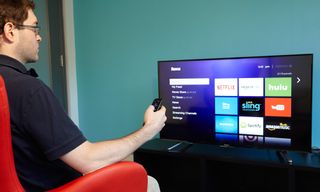
You'll still find the purple background, with a number of simple options for the main menu. From the home screen, you can access your favorite streaming channels, monitor items on your Feed (more on this later), access M-Go (Roku's preferred shop) for TV and movies, read up on the latest news, acquire new channels, and access the settings menu.
The main menu is pretty straightforward, and I especially like that you can customize which channels appear on your home screen. If you want Netflix, Hulu and Amazon Instant Video front and center, that's fine — and if you want a bunch of public domain horror movies and goat cameras, that's fine, too. Customizing home screens is such a convenient feature that it's shocking that competing operating systems like Amazon Fire and Android TV have not adopted it yet. (Apple TV also allows you to customize your home screen.)
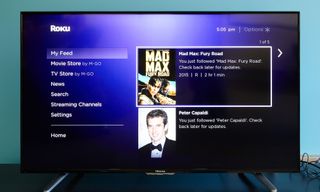
My Feed, which debuted earlier this year on all Roku devices, is a surprisingly useful feature. It allows users to follow upcoming movies, TV shows and actors. Once you set up what you want to follow, the device will send notifications when related content becomes available or when the price drops. Whether you're monitoring a movie that just hit theaters or one that came out on video decades ago, you'll be the first to know when it pops up on Netflix.
Still, there's something that feels overly familiar about the menus. The purple background with a bunch of square channels is a Roku hallmark at this point, but it's not nearly as attractive as the flashy Android TV interface or as tuned into your tastes as the predictive Fire TV menus. While the Roku 4 succeeds in being straightforward and navigable, its new OS had the opportunity to provide users with something a bit more futuristic, but played it safe instead.
Remote
The Roku 4's remote may be bulky, but it's still one of the best on the market. The peripheral features a directional pad, a confirm button, pause/play, fast-forward, rewind and a handful of extra buttons to take you directly to apps such as Netflix and Amazon Instant Video.
What really sets the Roku 4's remote apart from most others is the headphone jack. By plugging in a pair of included headphones (or you can supply your own), you can pipe whatever's on TV directly into your ears. This is an incredibly useful feature in case you're trying to avoid disturbing a spouse or roommate, or in case someone decides to cook, vacuum or assemble a string quartet in the next room. You can also control the volume of the program right from the remote, which gives it a slight advantage even over similar devices such as the PS4 controller.
The search trawls more than 20 services, including Netflix, Hulu, Amazon Instant Video, Crackle, HBO Go, M-Go and Vudu.
Roku has also added a button on the Roku 4 box itself, which users can press if they lose the remote. The remote will then emit a loud tone until the user finds it and hits the OK button. In our tests, it functioned from up to about 30 feet away, which makes this feature useful if you've dropped your remote into the couch, but less so if it's buried somewhere in the basement.
Search
Roku 4 features both a text search and a voice search, and the two are extremely robust. The device trawls more than 20 services, including Netflix, Hulu, Amazon Instant Video, Crackle, HBO, Go M-Go and Vudu. Neither Amazon nor Android TV include Netflix in their universal searches, which is a big feather in Roku's cap.

On the other hand, the Roku 4 lacks a virtual assistant, like Alexa on the Fire TV or Siri on the new Apple TV, putting it a bit behind the curve. This means that while you can search for content, you can't ask the Roku 4 to open apps, tell you the weather, play a particular piece of music or add appointments to your calendar.
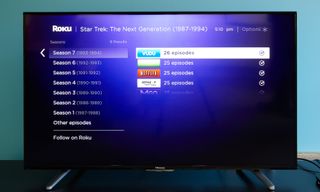
However, the Roku 4 had no problem parsing my voice, and tended to guess my text entries correctly as I was entering them. I searched for a variety of actors and TV shows, like Peter Capaldi and Star Trek: The Next Generation, and didn't encounter any errors along the way. You can search for streaming channels the same way.
The 4K video looked phenomenal.
In terms of content, Roku has one of the most comprehensive and sensible searches of any streaming device. For overall functionality, though, Roku's competitors are starting to surpass it.
Performance
I tested The Roku 4 across a variety of channels at both 4K and 1080p resolution, using both Sony X940C and Hisense H7 TVs. The 4K looked phenomenal. Watching the first scene of Orphan Black, I could not only make out individual strands of hair on Tatiana Maslany's head, but also read all of the signs in the background when she disembarked at a busy train station.
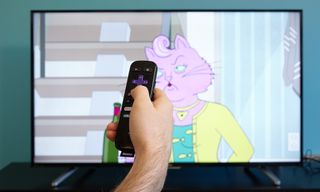
The Roku 4 supports 4K content at up to 60 frames per second, unlike the Fire TV, which caps at 30 fps. I watched a variety of 4K content, including Jerry Maguire, Orphan Black, Mozart in the Jungle and a Ukrainian cartoon called Eskimo Girl. (Note to potential viewers: Do not watch Eskimo Girl. It may be the most grating cartoon I've ever seen, and I grew up during the era of Catdog.) All of it looked extremely smooth and fluid, and helped justify using a 4K TV over a 1080p model.
The Roku 4's menus run at 1080p, but you can set up 4K screen savers. Doing so was very simple: All I had to do was upload 4K photos from my phone via the Roku app, and from there, the device assembled them into something I could look at whenever the Roku went to sleep.
The menus felt just a tiny bit sluggish, particularly the keyboard. It's nothing that'll ruin your streaming experience, but navigating from place to place seemed to take a fraction of a second longer than on most competing devices, and screens will hang in place for just a tiny bit before moving onto the next menu.
Content and Apps
The Roku and Fire TV are more or less neck-and-neck in total number of apps, but since a huge chunk of Amazon's apps are games, Roku still firmly leads the pack in channel selection. Heavy hitters like Netflix, Hulu, Amazon Instant Video (missing on Android TV platforms and Apple TV), Pandora, Spotify and YouTube are all accounted for.
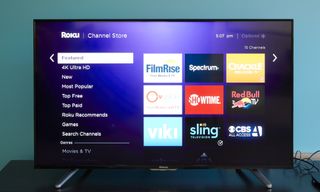
Subscription services like HBO Now, Sling and Showtime Anytime are present. If you have cable, you can watch ESPN, CBS, Fox News and a ton of other stations through those networks' Roku apps. Aside from PlayStation Vue, I can't think of one major (or minor) service that Roku is missing.
In terms of 4K content, the record is a little more mixed. While Roku 4 has the biggest selection of 4K streaming-video apps available on any platform right now, that still doesn't amount to much. Netflix, Amazon Instant Video, M-Go, Vudu, YouTube and a cartoon channel called Toon Goggles all support 4K streaming. And right now, that's it.
MORE: Best Streaming Video Services
The channel selection will, of course, grow over the next few years, but Roku is not the only platform out there. If you have a 4K TV, it's likely a smart model. That means you can already stream Netflix and YouTube in 4K, and possibly Amazon Instant Video as well. If your TV runs Android TV, LG webOS, Samsung Smart TV, Roku OS 7 or another major platform, you'll probably be able to access all the major 4K apps within the next few years. The major advantage of having a Roku 4, then, would be to see what kind of niche 4K channels surface between now and then.
Games
You can play games on the Roku, but they're hardly worth mentioning. The selection has grown extremely slowly over the last few years, and with a number of exceptions that you can count on two hands, the games are terrible, halfhearted knockoffs like Rockswap Adventures (Bejeweled), BORK (Breakout) and Four in a Row (Connect Four), which work by using the remote as a makeshift NES controller.
While systems like the Fire TV and Shield TV have tried to integrate gaming in a big way, the Roku 4 seems content to offer a selection that resembles what you'd find on a feature phone circa 2005.
Bottom Line
The Roku 4 has a lot of things going for it. The 4K streaming looks gorgeous; the content selection is still king, and the search is one of the best in the business. On the other hand, other than 4K, not much here justifies the $30 bump over the 1080p Roku 3.The Roku 4 doesn't really feel any snappier than its predecessors. You may be able to get a good amount of 4K content on the smart TV you already own, and in terms of gaming and extra features, the Fire TV and Shield TV have already left that TV in the dust.
The Roku 4 is best for customers who already own a 4K TV and want niche content beyond their set's built-in apps.
Sign up to get the BEST of Tom’s Guide direct to your inbox.
Upgrade your life with a daily dose of the biggest tech news, lifestyle hacks and our curated analysis. Be the first to know about cutting-edge gadgets and the hottest deals.
Marshall Honorof is a senior editor for Tom's Guide, overseeing the site's coverage of gaming hardware and software. He comes from a science writing background, having studied paleomammalogy, biological anthropology, and the history of science and technology. After hours, you can find him practicing taekwondo or doing deep dives on classic sci-fi.
